-
About
- About Listly
- Community & Support
- Howto
- Chrome Extension
- Bookmarklet
- WordPress Plugin
- Listly Premium
- Privacy
- Terms
- DMCA Copyright
- © 2010-2025 Boomy Labs
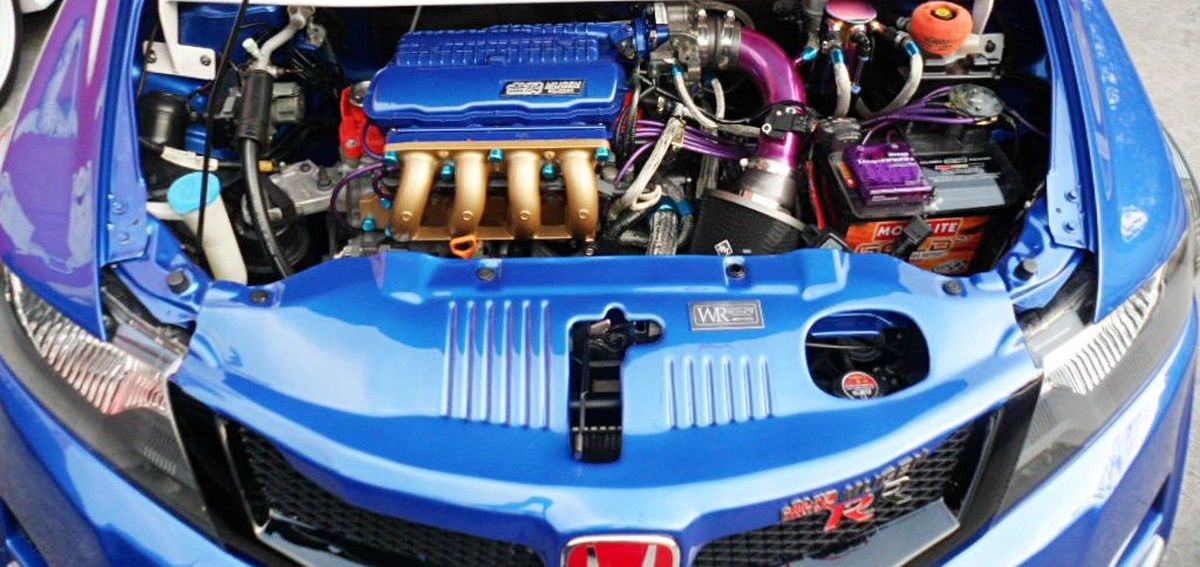

 John Huh
John Huh
Listly by John Huh
Honda engine swaps are nothing new to the world of import performance. In fact without many of these popular Honda engine swaps, it's hard to imagine what sport compact tuning and small displacement engine performance would be today.
Whether you drive a Civic, Integra, Del Sol, or CRX, our Top 10 Best Honda engine swaps guide will help you identify what Honda engine swaps are most popular. This helps you plan ahead and avoid making any mistakes with your build, that waste precious time and money.
Of course if you are planning to do a Honda engine swap, or need some guidance on wiring, how to fix your VTEC, your engine swap harness or what Honda engine swap mounts you should use, our master primer article named Honda Swap Combinations shows you what fits what. Our guide to the Top 10 Best Honda engine swaps is ranked by cost, ease of build and of course the bang for your buck factor.
Hopefully this Honda engine swaps list will help you make a choice when it comes to swapping a Honda engine into your car. Do you see an error or a Honda engine swap candidate that we left out? Help us by contributing and making our Top 10 Best Honda engine swaps list more accurate.
If you are looking for more tech tips, How To's or DIY articles on Honda engine swaps or engine swaps in general? Make sure to check our links at the bottom of our Top 10 Best Honda engine swaps for more help with your Honda engine swap.
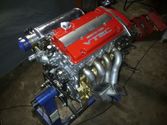
One of the best possible combinations of cost and horsepower, the G23 engine swap in a Honda Civic is not for everyone. Gone are the easy bolt in and swap guides, because most of this engine build will require some serious planning and engine work. This is a frankenstein of Honda engines, made up of several different Honda engine components.
The use of a SOHC 2.3 liter F23 shortblock with a H22 cylinder head can result in an excellent 2.3 liter VTEC Honda engine. People with the proper knowledge and patience and build an awesome G23 that delivers more power and torque than the K series engine, at a fraction of the cost. When installing an upgraded clutch, it's a good idea to step up your clutch master cylinder like this unit. It's designed to deal with the high pressure nature of your pressure plate in the 2.3 liter engine and allows you to shift faster and more crisply.
Where most K series engine swappers are going over 7,000 dollars in parts and components, the right G23 can be built for well under 2,000 dollars.
Why the G23 VTEC swap in a Civic works -
Torque - And lots of it with the 2.3 liter SOHC F series shortblock, and if you are looking for an all-motor solution the G23 VTEC engine swap is one of the very best.
Cost - Cheap and well under the cost of a K series engine swap or J series engine swap, you won't get a better dollar to horsepower ratio out of any other engine swap on our Top 10 Best Honda engine swaps guide.
Why the G23 VTEC swap in a Civic doesn't work -
Not easy - Again, not rocket science but if you just buy the parts and expect it to slap together, you've got another thought coming. The G23 is a great and flexible build, but again it's not for everyone. If you are not comfortable putting an engine together or checking for clearances, it's best to seek a pro who can help you with your project.
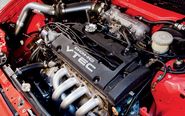
The black sheep of the Honda engine family has enjoyed a recent revival of sorts, as the H series swap in a Civic has found new life with the H2B transmission conversions. Using the B series transmission allows H swapped Hondas to enjoy the wide range of B series transmission components like flywheels or clutches.
Further the shortened gear ratio and host of aftermarket parts for the B series transmission make it easily one of the most popular mods for anyone who owns a H series swapped Honda.
You can find the H series engines in the Honda Prelude, from 1992-2001.
Why the H series swap in a Civic works – Lots more displacement available to you, and the H2B or H series swap is also smog eligible for those who live in California or Arizona. With a few engine tweaks and tuning, achieving 220+ wheel horsepower isn’t very difficult.
Why the H Series Swap in a Civic doesn’t work - The H series engine is larger and thus has much more bulk to the equation of figuring out which is the best Honda engine swap. Things like balance shaft belts will add to the complexity of your engine maintenance.
Engine modification components won’t be as cheap compared to your B series peers, but there’s still a healthy variety of parts to choose from.
Mounts – Because the H series engine was never intended to fit in a Civic or Integra chassis, you won’t be able to combine factory OEM Honda mounts to complete your Honda swap.
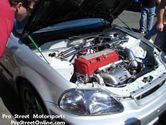
The cutting edge technology that drives the new i-VTEC mechanism in the K series engines first burst on the scene in the Honda Civic EP3 Si. This DOHC engine strays quite a bit from the older B series cousins, but the K20 is undeniably at the forefront of Honda engine swaps. For more reading on the K series, check out our What is the K20 primer here.
Available in many Acura and Honda vehicles, the K20A is found in the early 2002-2004 Acura RSX Type S, after this year range it’s the K20Z1. Many of the later model K series engines also come as a larger displacement motor, with a 2.4 liter K24.If you can source one from a TSX with a six speed manual transmission, building a K24 hybrid can provide over 220 naturally aspirated horsepower which makes for a potent power to weight ratio.
The new i-VTEC variable valve technology is what pushes these K series swaps onto the Top 10 Best Honda engine swaps list. Available with 197hp on entry-level 2.0L engines, you can find JDM versions that can exceed 220 horsepower in factory form.
Why the K series swap in a Civic works – As the next step in Honda’s VTEC technology, the K series has plenty of love from the aftermarket companies and support. If there’s a part you need or modification you aren’t sure about, finding information on the K series engine swap is easy.
Why the K series Swap in a Civic doesn’t work– It’s not the cheapest engine swap out there, and people predicted that the price point would be driven down as time goes by, but this swap is still pretty expensive. If you have over $6000 dollars burning a hole in your pocket, that can get you started. Compared to other options on this 10 best Honda engine swaps, this price makes this swap prohibitive to many people.
You also need several changes and additional components to make a K series swap in a Civic work. The additional cost of these parts and components detracts from the overall value of this Honda engine swap combination.
Mounts– You won’t need as much modification as the J series engine swap, but modification is still required.
Transmission Differences - Have a K20 swap engine but not sure what the differences are between the different K series transmissions? Check out our how to guide here.
Because the exhaust now faces your engine firewall, smogging your Honda engine swap will be difficult if you live in a state that cares about that kind of thing.

The B20 is the 2.0 liter version of the popular B series engine, commonly found in the Honda CR-V. This engine is cheap and plentiful, making it a great choice for the Top 10 Best Honda engine swaps list. Like the other B series engines in the family, installing a B20 into your Civic or Integra is very easy and can be done using stock or factory mounts.
Why the B20 series swap in a Civic works -It's cheap and there's so many of them that finding a replacement is easy and stress-free. The larger displacement makes the magical 200 wheel horsepower number a bit easier to reach if you are intent on staying with a B series.
Why the B20 series swap in a Civic doesn't work -
VTEC - It's not VTEC from the factory, so unless you are willing to build an LS/VTEC, this won't be available to you. Building the LS VTEC is very easy, and for a guide on how to build a reliable LS VTEC, check our guide here.
Smog - You also won't be able to smog your Honda, because the CRV is listed as a light truck. CARB certification and making your Honda swap 50 state legal is not possible with this configuration.
Internals - Like the non-VTEC B18 the B20 isn't meant to rev as high as the GSR or Type R engines. Because of this, if you want to swap a B20 into your Civic, it's best to take the proper steps so that you don't stretch your connecting rod bolts.
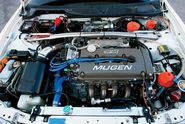
And you were expecting???
When you think about every single way you can imagine the pros of a B series engine swap, the B18c1 simply trumps them all. Cheaper than the Type R engine B18C5, and more torque than the B16, the B18C1 is found in 1994-2001 Acura Integras with VTEC.
The cost of the B18C1 engine swap has gone down somewhat, but it's still not very cheap because of the high demand. Swapping a B18C1 into your Civic can radically transform how your Civic drives from the get go. You'll be an immediate difference down low as well, unlike the B16.
Why the B18C1 swap in a Civic works -
Bang for your Buck- High bang for your buck value when you compare how easy this swap is compared to any of the others on our Top 10 Best Honda engine swaps countdown.
Ease of Install - If your Civic has VTEC already, this is probably the easiest motor swap project you could undertake. Check our Honda Swap Combinations guide to see what fits what.
Parts, Parts, and more parts - Let's face it, there's more parts and components for the B series and the B18C1 than any other Honda motor ever. No matter what part you need or want for your B18C1, chances are someone makes them.
The B18c1 is also readily available and their demand decreases every passing day. You don't have to resort to importing a JDM B18C1 to get your GSR swap done.
The Law - You can also very easily smog your B18C1 swap, because so many of the factory Acura Integra smog parts can be installed in your Civic.

We are stepping outside of the box here at the halfway point of our Top 10 Best Honda engine swaps list, with the F20 S2000 Honda swap. Available from 1999-2005 the S2000 is a track ready roadster powered by the 2.0 liter F20C as well as the 2.2 liter in the F22C.
Yes, we realize this is a rear wheel drive layout, but that’s not stopping people from converting their Integra or Civic to rear wheel drive. Of course this countdown is for Honda engine swaps only, which also makes the F20C or F22C perfect for other rear wheel drive chassis.
Why the F20 S2000 Swap works – Technologically superior and one of the best power to displacement ratios, the S2000 Honda swap is high revving track engine that’s got lots of potential. The F20 S2000 Swap engines also boast an impressive 162lb-ft of torque.
Why the F20 S2000 Swap doesn’t work
There’s quite a few reasons why the S2000 swap isn’t the best, but as far as the unique factor goes, it’s off the charts. Here’s a few bullet points on why the F20C or F22C S2000 Honda swap may not be the one you want to go with.
Rear Wheel Drive? - Pretty obvious isn’t it? You’ll need rear subframe work along with locating and installing a rear end. Your shifter linkage will need to be reworked, as the newly added driveshaft is sure to complicate matters.
Cost – It’s not cheap and the fact you’ll be converting to rear wheel drive doesn’t help matters. Want to know how much more it will cost than a normal Honda engine swap? Factor your new subframe, new rear end, new axles and driveshaft, and the labor for all this stuff.
Add to the cost of your S2000 Honda swap, and you’ll get close to the final tally.
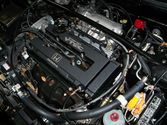
Easily one of the most popular Honda engine swaps out there, the B16 is the engine that Honda should have put into USDM Civics from the get go. DOHC configuration and lots of value for the B16 engine swap. There's so many B16's out there that sometimes the biggest challenge can be figuring out exactly which B16 engine you have as a donor.
A large source of these B16 engines is of course imported JDM engines, which results in a roll of the dice to see what B16 you might receive.When discussing JDM imported engines, there’s a few versions of the B16 you are likely to see at your importer. The first generation B16A utilizes a 10.2:1 compression ratio and puts down 160ps of horsepower. The second generation B16A received a bump in compression to 10.4:1 and with changes to the cam profile puts down 170ps of horsepower.
Why the B16 swap in a Civic works
Cost - It's cheap and plentiful, what more do you want? Replacement parts and JDM engines can be sourced for extremely cheap considering the large selection to choose from.
Easy to swap - As simple as a bolt in project, swapping a B16 engine into your Civic is easy especially if your Civic already has VTEC.
Why the B16 swap in a Civic doesn't work - It's a bit nitpicky, but if you are planning a swap to a B16 don't expect a huge change under 4000 RPM. Because the 1.6 liter SOHC version of the engine in your Civic stock doesn't feel much different than a B16 under 4000 RPM, this can be a negative to an otherwise excellent Honda engine swap.
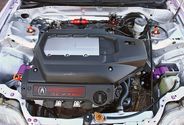
The J Series Swap in a Civic kicks off our list of Top 10 Best Honda engine swaps, and for good reason. More displacement and the larger engine means there’s no need for many additional modifications or changes. Good thing because once you’ve put one of Honda’s 60-degree V6 J-series engines in your Civic, you won’t have room to much of anything.
Found in a variety of Honda passenger vehicles, like the Honda Accord and the corresponding Acura models like the CL, TL, RL, TSX, TLX, RLX, RDX, MDX and ZDX, the J series swap in a Civic is very unique. Because this engine is so widely found in the US, this lowers the price point and can make this Honda swap combination an excellent choice.
Why the J series swap in a Civic works - Lots of value for a J Series Swap in a Civic means you get more for your money. With 240 horsepower on tap, once you get the actual J series swap in your Honda the hard part is just about done.
Why the J series Swap in a Civic doesn’t work– There’s several reasons why this swap isn’t higher on our countdown of Top 10 Best Honda engine swaps. Let’s take a look at a few major bullet points.
Weight - Because of the added weight and heft of the V6 engine, it’s one of the heavier Honda engine swaps you could go with. This could unbalance your vehicle and cause understeer issues. It’s best to take the proper suspension measures to make sure that this does not happen.
Support – Simply put, there’s just not much support or love for this engine. You’ll see your friends and peers that went with a B series or even a H2B setup, have more product support and manufacturer support that sadly your J series will never get close to.
Mounts– For some people this point isn’t as crucial for our Top 10 Best Honda engine swaps countdown, but you won’t be able to use a combination of Honda engine mounts to get the J swap done.
Heavy modification will include drilling into your frame and modifying your engine bay for the aftermarket mount kits to work. Because the transmission is cable actuated, you will need to drill and cut around your shifter hole to mount a shifter box complete with cables.
Needless to say, you aren’t just “going back to stock” after completing a J series swap in a Civic.

OBDI B16a, B17a, B18a – A healthy bump up in torque and power (especially with the VTEC B16) however much of the down low grunt will feel similar to your SOHC.
Transmission: If you locate this motor and transmission from a wrecker together, you will have a cable clutch transmission which means you will require a conversion unit to allow for usage on your hydraulic vehicle. Check out Hasport, Innovative and many more mount companies for this conversion piece that will make your hydraulic clutch work with a cable one. Conversely you could opt for a Y21, Y80, S80, S4C, which are all hydraulic clutch transmissions and use the traditional slave and master cylinders.
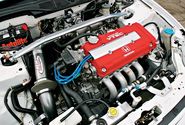
The first of the B series engines cracks our Top 10 Best Honda engine swaps list, the B18C5 is the best possible factory engine from this era. Bolt this engine in if you don’t want to tune or modify the engine any further, and you’ve got yourself a potent combination of small engine displacement and a sky high rev limiter.
Popular and lots of JDM factor, if that’s something you are into. The ease in which the B series engine can be swapped into a Civic is frankly ridiculous, for a guide on how to swap a B series, check here.
Why the Type R Swap in a Civic works – If you want to bolt it in and go without bothering to modify or improve the engine’s performance, the B18C5 is the way to go. No need to mess with cam profiles or cam gears, simply installing a Type R engine will radically transform your Honda Civic.
Why the Type R Swap in a Civic doesn’t work– It’s not cheap and in fact it’s still prohibitively expensive to swap a true B18C5 into your Civic. With the amount of normal B18a, B18B and B18C1 engines out there, it wouldn’t be financially wise to jump straight to the B18C5. We’ll get to that later in our countdown of Top 10 Best Honda engine swaps.
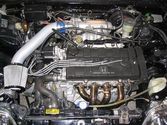
People who have a non-VTEC B series swap in their Honda Civic can take the next step and use our LS VTEC guide to build the ultimate reliable LS VTEC setup. Many times the LS engine can be a better choice than the B16 or B18C1, with low boost friendly compression and lots of torque from the get go.
The installation of the LS swap in a Civic is the same as all the other B series engines, meaning very very easy. Using stock mounts is recommended, and knowing how to swap a B series is one of the easiest Honda swaps out there.
Why the LS Swap in a Civic works -
Cost - The non VTEC DOHC 1.8 liter engine is cheap and there's lots of them. Many owners opt to ditch the LS engine, and because of this there's less demand which in turn lowers your price.
Ease - Like all other B series DOHC powerplants, installing and swapping them into a Civic is easy as pie.
Why the LS Swap doesn't work -
VTEC - This needs to be wired in, and while it's not rocket science, you'd be surprised how many people are daunted or feel as though they can't do this work. Check our How to on building and wiring a proper VTEC build, or check our troubleshooting guide to why VTEC is not working.
